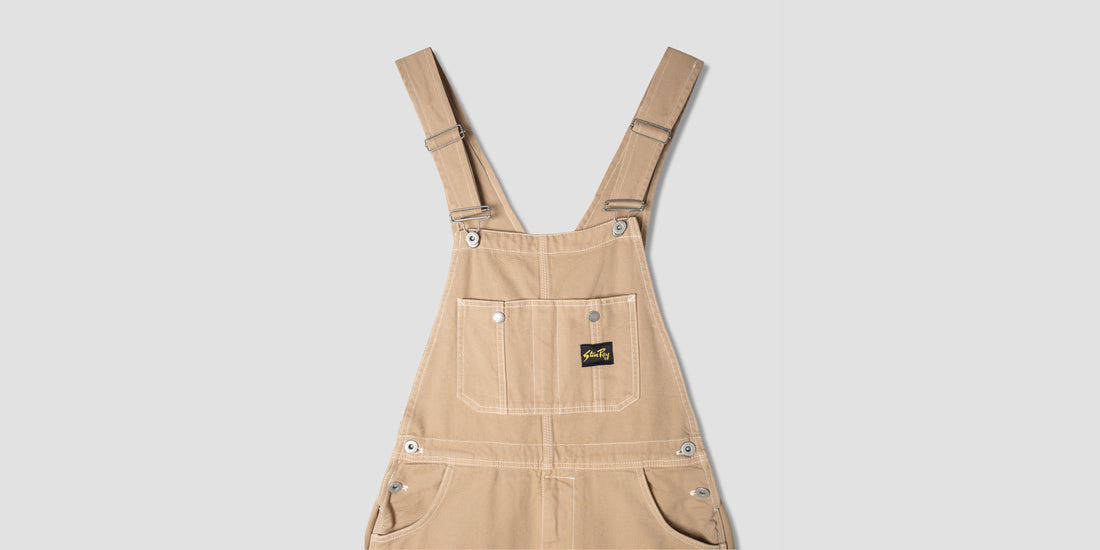
A Brief History of Dungarees.
Dungarees are a prime example of work-wear that works far and wide. Created for serious graft, their no-nonsense design means they're at home right across the board, everywhere from the workshop to the skate spot. We’ve been making ours for a good while now—and apart from a few very minor tweaks to the shape (with a little bit more taper on the legs), our Earl’s Bib dungarees are exactly the same as the ones we were making in the ‘70s, back in the early days of Stan Ray. With nearly 50 years worth of dungaree-making under our belts, it’s a design we’d like to think we’ve mastered—and when it comes to hardy overalls, fit for both work and play, Earl’s Bibs still can’t really be beat.

Whilst our design dates back to the mid-70s, the archetypal front-bib work overall design stretches back even further—and whilst dates are a little hazy, American workwear companies were making them as far back in the late 19th century. A development of an earlier, more basic form of workwear unglamorously known as ‘slops’ (which were basically baggy, featureless overalls), these ‘denim waist overalls’ were built for the new wave of miners, farmers, factory workers and mechanics who were forging a new frontier—a direct reaction to the rigours of the industrial revolution.

A far cry from an afternoon hot-desking in an air-conditioned creative suite, these muddy, oily, jobs required serious clothing that could put up with serious stick, year after year after year. Function was firmly at the forefront—and for good reason. Superfluous details would only get in the way, and with ‘health and safety’ still a distant concept, the risk of getting chewed up by high-powered machinery was always lurking.
Bib overalls (as dungarees were known in the States) were the perfect solution. Designed to be worn ‘over all’, they were roomy enough to cover a shirt and trousers, keeping the wearer and their clothes out of harm’s way. Copper rivets and triple stitching kept things reassuringly sturdy, whilst the array of pockets meant tools could always be kept to hand.

The sheer simplicity was also part of their appeal, and whilst modern workwear can often rely on technical fabrics and complex construction, ripped knees or torn pocket-bags on denim or hickory dungarees were an easy fix that could be quickly sorted by anyone with a sewing needle and a bit of surplus fabric.
Worn widely across the U.S. for a whole host of jobs, dungarees soon became a symbol of the working man… and by the time the heavy artillery of the first World War were wheeled into action, a symbol of the working woman too. With millions of women sent to toil away in factories or on farms, long skirts were replaced with utilitarian work-wear, and by WW2 the images of Rosie the Riveter or the Land Girls became synonymous with the battle at the home-front. As one particularly patronising American government advert asked, "Can you use an electric mixer? If so, you can learn to operate a drill."

The idea of ‘dungarees as a symbol’ has lived pretty much as long as dungarees have been around. In the 1920s there was even a group dedicated to them known as the ‘Overalls Club’. With wild inflation after WW1 causing clothes prices to rise, a surprisingly large group of activists across the USA took to wearing affordable overalls—not just for manual labour, but in offices and courts too—touting functional work-wear as the antithesis to overpriced formal garb. Ironically this new demand for dungarees ended up forcing the prices up, with a regular pair shooting up from two dollars to six. What’s more, it was thought by some that the whole thing was a conspiracy dreamt up by southern cotton growers to up the price of their product.

Whilst the Overalls Club only lasted a few years, the political power of dungarees didn’t wane, and in the 1960s they played parts in both civil rights and women’s lib demonstrations, with activists like Stokely Carmichael and James Forman often marching in denim overalls. Like the duffle coat or the M-65 jacket, dungarees lived a double life—equally at home in a foundry or a picket line. Their humble, functional nature marked them firmly as ‘anti-fashion’, the perfect statement of authenticity and realness in the face of gaudy excess and lavish gimmickry, which is probably why so many bands and musicians have worn ‘em over the years.

From Ronnie Wood to Tupac Shakur, via Dexy’s, Andre 3000, Michael Stipe, Patti Smith, the Fugees… and Marshall Mathers in his ‘hockey mask and chainsaw’ era, the sheer list of people who’ve worn them is too big to cram in this mere article. In an industry heavily based around image and aspiration, the simple act of wearing something functional and affordable has become a statement in itself.

The fact that they’re really comfortable, they’re really tough, and they’re really useful probably helps too. That’s how we like to make ours. Following our classic recipe, we think our Earl’s Bibs are just how dungarees should be. No weird gimmicks or superfluous details here—just heavyweight 14oz cotton duck, plenty of handy pockets and a roomy, relaxed shape. Whether you’re raising a barn, baking a swanky bread loaf or making a stand, they’re just right.
Words by Sam Waller.